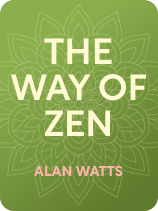

This article is an excerpt from the Shortform book guide to "The Way of Zen" by Alan Watts. Shortform has the world's best summaries and analyses of books you should be reading.
Like this article? Sign up for a free trial here.
What are the principles of Zen Buddhism? How is Zen Buddhism expressed and experienced? Is this philosophy for you?
Many people have a passing familiarity with the concept of Zen. But, few really know what “Zen” means or could articulate how Zen Buddhism describes reality and human life. In The Way of Zen, Alan Watts explains the major principles and the history of Zen Buddhism.
Continue reading for an overview of the book that’s likely to answer many of your questions.
Overview of The Way of Zen by Alan Watts
We go through our lives wrapped up in ideas, value judgments, and rules about the events, objects, and people around us. We even apply these social conventions to our understanding of ourselves. But, according to Zen Buddhism, all of these conventions are artificial and represent just one superficial way of engaging with and understanding the world.
By learning to express the principles of Zen, you can break down the mental barriers that you use to divide yourself from the rest of the world—and, finally, see the world and the present moment for what it is. You can achieve this change in perspective without spending your life in strict meditation or dropping away from your family, your friends, your work, or the activities you value.
The Way of Zen by Alan Watts is an introduction to Zen Buddhism that was first published in 1957. Watts is a philosopher who’s been credited with popularizing Zen in the West in the 1960s. He wrote a number of books based on Zen Buddhist, Taoist, and Hindu ideas, including The Book (1966) and The Wisdom of Insecurity (1951).
We’ll explore how Watts defines Zen, what schools of religious and philosophical thought it grew out of, and what differentiates Zen from those traditions. We’ll also look at why Zen is still relevant in our modern world, how Zen might change your perspective on your life, and how to express Zen in your everyday life.
What Is Zen?
Zen Buddhism is a “way of liberation” from the illusions you believe about the world and yourself. Watts writes that Zen frees you to perceive the world in a more natural way, and you can experience this liberated way of moving through the world when you understand that you’re already enlightened due to your nature as a human being.
We’ll explore where Zen came from, consider the most important ideas that Zen adopted from the ancient philosophies and religions that preceded it, and explain which ideas differentiate Zen from other schools of thought.
Where Did Zen Come From?
According to Watts, the traditional origin story of Zen credits a monk named Bodhidharma with introducing many of the ideas that would become Zen Buddhism. The story goes that Bodhidharma arrived in China from India in the year 520 and spent nine years meditating in a cave at a monastery in Wei. There, he became the first patriarch of Zen.
Several other monks played important roles in the origin of Zen, too. Seng-chao, a copyist of Confucianist and Taoist texts, read a Mahayana Buddhist text that explained that awakening could be experienced in everyday life. He went on to produce writings of his own, explaining Buddhism in terms of Taoism and forging a link between Taoism and Zen. Similarly, a monk named Tao-sheng seems to be the first to have taught that awakening can be instantaneous.
Watts explains that ultimately, Zen was created as a “way of liberation” to undo the effects of the conventions that we learn in society—effects such as indecision, anxiety, and self-consciousness. Zen created a synthesis of Chinese and Indian traditions, and after its origin in China, it spread outward, most notably to Japan.
What Ideas Did Zen Borrow From Taoism, Confucianism, and Mahayana Buddhism?
Zen and its ideas can be traced back to three schools of thought: Taoism, Confucianism, and Mahayana Buddhism. Taoism and Confucianism are Chinese forms of thought and religion, while Mahayana Buddhism is an Indian school of Buddhism. Each contributed ideas that would become foundational to Zen Buddhist teachings about life and enlightenment. We’ll outline which ideas Watts identifies as having made the most crucial contributions to the development of Zen. Those ideas concern the nature of our perception, awakening, and our actions in the world.
Confucianism
Confucianism influenced Zen indirectly by affecting the organization of ancient Chinese society. Watts explains that Confucianism is humanistic: It creates a social order focused on harmony, ethics, and communication by teaching people to follow social conventions. When Confucianism absorbed Buddhist practices, this interweaving of ideas led to an attainable way for the average person—who has work, family obligations, and interests—to practice Buddhism and experience awakening. By contrast, other forms of Buddhism teach that attaining awakening would take lifetimes of effort across multiple cycles of reincarnation.
Taoism
A second school of thought that shaped Zen Buddhism is Taoism, which proposes what Watts calls a liberation from Confucianism. Whereas Confucianism emphasizes the importance of ethics and social conventions, Taoism aims to help people see those conventions for what they are: socially agreed-upon meanings and values rather than something real or concrete. Taoism proposes that realizing the true nature of these conventions enables us to step back from them and experience life in harmony with the universe as it actually exists.
Two ideas of Taoism became foundational to Zen Buddhism: the idea that we can experience two different kinds of knowledge and the idea that we can act spontaneously in the moment.
There Are Two Ways of Knowing
First, the Taoist idea that there are two kinds of knowledge—conventional and unconventional—deeply influenced Zen. Conventional knowledge is contingent on socially agreed-upon meanings and value judgments. Watts writes that these are culturally defined and have to be represented in language (or other forms of notation, like mathematical equations). Facts, labels, and definitions are conventional knowledge.
On the other hand, unconventional knowledge doesn’t rely on the abstractions of language and representation. Instead, it gets directly at the experience of the actual world. When you’re walking under an oak tree, you might feel its shade, take in the scent of its leaves, and watch the movement of its branches. Your experience of observing it without naming or describing it is unconventional knowledge. We often assume that we can’t “know” something unless we can express it in language. But Taoism proposes that unconventional knowledge enables us to know the world directly, by experiencing it.
We Can Act Spontaneously and Naturally
Another idea that’s foundational to Zen comes from the Taoist principle wu-wei, the experience of making decisions naturally and spontaneously. Watts writes that when you let your mind decide how to act, it moves more naturally and intelligently—not impulsively, but out of the spontaneity of the moment. This leads to the experience of wu-hsin, translated as “no mind,” a kind of “un-self-consciousness” that you can experience when you let your mind work without trying to direct it or interfere with it. You can develop te, or “virtue,” a creative ability that you can only access by acting naturally and spontaneously.
Watts traces this logic a step further and explains that not only can you act spontaneously, but there’s no other way you can behave. If you realize that even your intentions, purposeful actions, and voluntary decisions arise spontaneously from your natural self (the self that you actually experience, rather than the abstract idea of yourself), then you can stop trying to be spontaneous or worrying that you aren’t.
Mahayana Buddhism
A third school of thought that shaped Zen Buddhism is Mahayana Buddhism, which reframes the pursuit of nirvana, the traditional Buddhist idea of release from karma and cycles of death and rebirth. Mahayana takes the idea of this cycle figuratively, explaining that the pursuit of nirvana is futile and we’re continually reborn from moment to moment until we stop trying to escape what’s really happening in the present moment.
Two ideas from Mahayana Buddhism had a major impact on Zen: the idea that we don’t perceive the world as it really is and the idea that there’s nothing for us to attain in life.
We Don’t Perceive the Real World
Important to Zen is Mahayana Buddhism’s teaching that illusions obscure your perception of the world. Watts explains that the principle of maya is that the language we use to describe the world obscures what it really is. Maya is about relativity: We name things like “light” and “darkness” or “good” and “evil” and consider them opposites. But, in reality, they aren’t separate. Watts explains that Hindus and Buddhists refer to the world as “nondual” rather than as “one” because even the concept of “one” draws on a false duality (it’s conceptually opposite to “many”). Letting go of the impulse to name and delineate things enables you to perceive the relativity and impermanence of the world and experience moksha, a “liberation” from maya.
It follows from the principles of maya and moksha that language also curtails what you can understand of yourself. Watts writes that in all forms of Buddhism, you can’t apprehend your true self because there’s no permanent or unchanging self to understand. He points out that what you think of as your self or ego is just an abstraction. Your true self eludes your understanding if you hold onto that abstraction.
There’s Nothing to Pursue or Attain, Not Even Nirvana
Another Mahayana idea that’s foundational to Zen is the doctrine that there’s nothing for us to grasp at, even nirvana. (One of the Four Noble Truths of Buddhism is nirvana, which Watts characterizes as analogous to moksha. Nirvana is a state of awakening.) When we seek things, we fail to see that everything exists in a state of relativity, where nothing exists except in relation to other things.
The origin of this idea is unclear. Watts writes that some scholars think that one of the earliest ideas of Mahayana Buddhism was that one could be a Bodhisattva and reach enlightenment by foregoing nirvana until all beings can experience it. But Watts argues that the idea underlying the Bodhisattva is implicit in the logic of Buddhism: Nirvana is a state you reach when you stop trying to grasp reality. But if there’s nothing to grasp, then how is there anything to attain?
The word tathata, often translated as “suchness,” represents the true state of all beings, including Buddhas, people who have experienced awakening. That means that all beings can become Buddhas. It also means that by letting go of the abstractions through which you usually see the world and yourself, you can experience the world in its “suchness.” Watts explains that the use of a word like “suchness” to describe the true nature of all beings is intended to remind us that while “meaning” is a quality of thought or language, it doesn’t exist in the actual world. In other words, the idea of a person is separate from the reality of the person.
What Ideas Differentiate Zen from Other Schools of Buddhism?
While Zen was built on what came before, it’s a unique school of Mahayana Buddhism with many original ideas. We’ll explore how Zen Buddhism differs from other schools of Buddhism. The most important differences are its directness (in awakening and in teaching), its stance on meditation, and its principles about how you should use your mind.
Awakening Is Direct and Instantaneous
The first idea unique to Zen is its understanding of the nature of awakening. In other schools of Buddhism, you might have to work a lifetime to achieve awakening. But in Zen, awakening is immediate and can happen anytime. Watts explains that you don’t have to pass through a sequence of spiritual stages or spend your days in meditation to get there. Instead, awakening can occur instantaneously, an experience called satori. Zen teaches that you can experience awakening in everyday activities like working, creating art, and appreciating the natural world.
The point of Zen is not to experience awakening or to attain Buddhahood because you are already a Buddha by nature. To try to become a Buddha is to deny that you already are a Buddha. Additionally, Watts writes that you can develop prajna, a kind of direct knowledge or wisdom. The principle of prajna is that by seeing the relativity of everything (including the futility of the pursuit of goals), we come to know the truth of the world by not knowing it.
Zen Can Be Communicated Directly, Without Symbols
The second concept unique to Zen is its directness. Watts writes that Zen is unusually direct in the way it teaches and communicates. The Zen method of instruction, called wen-ta or the “Zen story,” typically takes the form of an anecdote where a question is asked and then answered. These stories aim to point the listener toward a realization, but they aren’t symbolic: The characters don’t represent something else, and there’s no metaphor.
Watts explains that the directness of a Zen story is typical of Zen’s directness in communication. A method of conveying insight called “direct pointing” involves demonstrating a Zen principle through words or actions that don’t overtly comment on the question in the story.
You Don’t Have to Control or Empty Your Mind
A third idea core to Zen’s teachings is the principle of wu-hsin, or “no-mind.” Building on the Taoist philosophy of naturalness, the principle of wu-hsin suggests that instead of trying to still, empty, or purify your mind, you should let go of your control of the mind itself.
Watts writes that when you combine wu-hsin, or “no mind,” with wu-nien, or “no thought,” you free your mind to act while thinking, without trying to second-guess or control it. The point of this un-self-consciousness is not to be unaware of what’s happening around you or within you, but to shift your attention away from conscious cognitive processes and toward a spontaneous and creative state. This involves just observing thoughts come and go, without suppressing them, holding onto them, or trying to interfere with them.
According to Watts, Zen became a new school of Buddhism because it took a new and unique view of dhyana, a concept that Watts notes is often but inadequately translated as “meditation.” He explains that dhyana might be better understood as a state of awareness that’s focused on the present and unconstrained by false boundaries between “the knower, the knowing, and the known.” In other words, Zen teaches that when we enter a state of dhyana, we look beyond conventional separations to see the world for what it is.
Why Should You Learn Zen?
Watts also discusses why you might want to practice Zen. We’ll explore why Zen is still relevant in modern life and explain what changes you might experience by expressing it in your life.
Why Is Zen Still Relevant?
One reason to dedicate time and attention to learning the principles of Zen is that they’re still very relevant. Watts writes that though Zen arose in a time and place that’s very different from what people experience in the West today, it can still help you learn some kinds of knowledge—and unlearn other kinds.
Because of its teachings about the nature of the world and your perception of it, Zen can help you see what’s false and artificial in your view of the world. Watts points out that your consciousness is only superficial—just one function of your true mind—and can only attend to a small part of reality at a given time. He notes that you can access a more holistic view of the present and the world if you practice the principles of Zen.
What Are the Benefits of Zen?
Another reason to learn from the principles of Zen is that you’ll notice changes in the way you experience the world when you adopt Zen ideas in your life. In this section, we’ll explain what these beneficial changes can look like.
Feel Liberated From Constantly Trying to Improve Yourself
The first change that Zen can help you make is to curb your innate desire to constantly improve yourself or your situation. Watts explains that this improvement is often an illusion of dualistic thinking—an illusion we can stop buying into to end the cycle.
He writes that we apply the same dualistic (and mistaken) pattern of thinking when we conceive of good and evil or pleasure and pain as opposite states. When you see that not only can one not exist without the other but that you can’t experience one without the other, then you stop striving against inevitable experiences like discomfort, pain, and frustration.
Feel Interconnected With the World, Rather Than at Its Mercy
A second change that Zen can help you make in your life comes when the practice reorients you to your relationship with the world. Watts writes that seeing beyond dualistic thinking can help you recognize that you aren’t as separate from the world as you think. While you think of your “self” as an entity separate from your body and your experiences, Zen teaches that those distinctions are artificial. Your idea of yourself is not your true self: It’s an abstraction you’ve constructed to feel security and sameness from one moment to the next.
Letting go of the abstract image you have of yourself can help you stop feeling that what happens to you is out of your control. It can also help you recognize that even voluntary and involuntary events are relative. Watts writes that when you experience the world in its “suchness,” you don’t experience it as an obstacle or as something that you need to control, but as something with which you’re interconnected.
Live in the Present—Because There Isn’t Anything Else
The third way that Zen can help change your perspective comes when a Zen understanding of relativity changes your relationship with time. Watts explains that learning to recognize time as relative can help you feel more still and calm no matter what’s happening. When you’re worried about the passage of time, it just seems to pass more quickly. But when you stop trying to hold onto it, its pace seems to slow.
Watts writes that a major idea of Zen is that you don’t have anything except the present moment. He explains that to Zen, the past and future are just abstractions, and the only moment that has any concrete reality is the one you’re living in right now. As long as you don’t label this moment the present—which implies that it’s separate from the past and from the future—then you can be awake and alive to just this moment.
How Can You Experience Zen?
There’s more to Zen than just a set of philosophical principles or a chronology of religious movements, which you can understand on an intellectual level. Zen is also something that you can experience in your own life, at the level of your embodied experiences in the world. We’ll explain briefly why Zen isn’t a practice per se, and then explore the ways it’s often experienced, looking at the starting points that Watts identifies for someone new to Zen and then exploring traditional practices such as meditation, Koan training, recreation, labor, and breathing.
Why Is It a Mistake to Think of Zen as a “Practice”?
It’s common but not entirely correct to refer to Zen as a practice. Watts explains that to understand Zen, you have to experience it. But that doesn’t actually mean practicing it in a formalized, structured way. Paradoxically, you can’t truly practice Zen if you’re pursuing it as a goal. Similarly, Watts writes that Zen life begins with the understanding that you can’t practice Zen to become a Buddha because you are already a Buddha.
To experience Zen, you don’t need to practice any method in particular, nor do you have to do or think about anything specific. Watts explains that Zen isn’t a means to the end of awakening; instead, awakening, or satori, comes when you don’t have a goal in mind and are instead just experiencing the present moment in the concrete world.
Where Should You Begin if You Want to Experience Zen?
It’s one thing to understand the basic principles of Zen, but it’s another to express those principles in the way you live. Watts offers two suggestions for beginning: The first involves stepping away from your abstract idea of the world, and the second involves seeking to experience the real, concrete world instead. We’ll look more closely at each of these suggestions.
Let Go of Illusions and the Goals That Follow From Them
To begin living a life of Zen, you first have to stop pursuing goals that reflect the abstract idea of the world. Watts writes that this means letting go of trying to experience the good without the bad: When you understand their relativity, then you can appreciate that there aren’t goals that can be set or achieved. Stepping away from illusions also means loosening your grip on trying to plan for a future that, according to Zen, doesn’t exist.
When you internalize the idea that there’s nothing to be gained or obtained in life and nothing except the present, then you can realize that none of your abstract ideas about self-improvement remain relevant to your true self. The way you do things matters more than the specific things that you do (or goals you set). Watts writes that Zen doesn’t demand that you engage in any specific practice or course of action: You can experience Zen in any activity.
Experience the World Around You
The logical counterpart to stepping away from your abstract idea of the world is opening yourself to experiencing the real, concrete world instead. Rather than naming and classifying experiences, observe them and encounter them as they really are. Watts explains that Zen masters don’t spend their time talking about Zen. Instead, they experience Zen by focusing on the tathata, the suchness or the concrete reality, of the world around them.
How Is Zen Expressed?
As we’ve discussed, it’s a basic principle of Zen that you can experience awakening at any point without having to participate in particular activities or meditate on specific ideas. However, Watts also writes that many traditional activities have historically been associated with the experience of Zen. In this section, we’ll describe the activities that have traditionally been used as an expression of Zen, including meditation, koan training, work, recreation, and breathing.
Meditation
One traditional Zen practice is sitting meditation, or za-zen, where you look at the world without thinking about it in abstractions. Watts explains that this practice helps you to see the “suchness” of the world since it involves letting your ideas about it fall away and experiencing reality as it exists right now.
Za-zen involves attending to what’s happening in the present moment, feeling a continuity between yourself and the world, and observing the absence of a boundary between your mind and the thoughts that run through it. This is a common way to express Zen, and Watts writes that Rinzai and Soto Zen monks spend a significant amount of time in the practice of za-zen. For them, the translation “sitting meditation” is literal: They practice za-zen sitting on a cushion in lotus pose.
Koan Training
Another traditional way of expressing Zen is the sanzen, where pupils in the Rinzai School visit Zen masters to present their understanding of Zen stories: kung-an or koans. Watts explains that in koan training, a student undergoes a series of 50 tests that take the anecdotes of historic Zen masters as their material. The student has to demonstrate that they understand the meaning of the koan. But they can’t just explain the story in words: The demonstration must be nonverbal and intuitive, and the student discovers its form in the process of coming to understand the koan.
When the student has found an answer to the koan, they present it to the Zen master using a verse from the Zenrin Kushu, a compilation of Zen writings. The student carefully selects the verse to convey what they learned from the koan.
Recreation and Work
Recreation and work offer another way to experience and express Zen. Watts explains that some Zen practices don’t emphasize za-zen; Instead, they teach people to use their everyday work and pursuits as a means of meditation. He notes that, traditionally, rituals like tea ceremonies, arts such as brush drawing and flute playing, and athletic pursuits like ju-jutsu, fencing, and archery all serve as a mode of meditation.
A traditional Japanese tea ceremony, or Chan-o-yu, translated as the “art of tea,” offers one way to express Zen. The tea ceremony is a ritual that, according to Watts, requires total immersion in the present moment, as tea is prepared and served in a traditional but secular ritual.
Traditional forms of art offer another way to understand and experience Zen (whether you’re practicing the art or just appreciating it). Watts characterizes Zen art as an expression of the artist’s experience of the present moment. Sumi-e, a style of calligraphic painting, expresses spontaneity in its depiction of natural scenes. Haiku, a short form of poetry, expresses the concrete reality of a moment in time, evoking its particular mood or sensation. These arts are intended to be practiced without making an effort, performed without separating thought from action and undertaken without setting goals for the practice.
Even work can serve as an expression of Zen when you approach it in the right mindset. Watts explains that historically, many professions and traditional crafts in Japan were regarded as lay methods for learning the principles of Taoism, Confucianism, and Zen.
Breathing
Finally, you can learn to express Zen in one of your most fundamental physiological activities: breathing. Watts notes that any activity can function as meditation. But no matter what practice you adopt for practicing Zen, a key part of Zen is breathing. Watts explains that when we breathe reflexively, our breath tends to be shallow. Proper breathing for the experience of Zen starts with the exhale, which should completely empty the chest and abdomen of air. Then, the inhale follows easily. The goal is not to breathe as an exercise but to become aware of and observe your breath as it moves in and out of your body.

———End of Preview———
Like what you just read? Read the rest of the world's best book summary and analysis of Alan Watts's "The Way of Zen" at Shortform.
Here's what you'll find in our full The Way of Zen summary:
- The major principles and history of Zen Buddhism
- How to experience Zen in everyday life—without a strict meditation practice
- Why calling Zen a "practice" is a mistake






